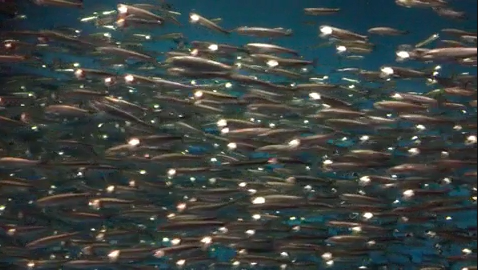The Global Ocean: Can We Overcome Our Failures and Move Toward Healthy Seas?

Anchovies at Monterey Bay Aquarium. Video: Michelle Morelos
SAN FRANCISCO—Just like us, marine species need safe places to call home. But the world’s oceans are no longer as safe. Climate change, ocean acidification and overfishing are the major problems faced by life in the sea.
Are there actions humans can now take to turn the tide and lift the gloom? An international panel of researchers tried to define the most serious problems, and identify some solutions, on 27 October at the World Conference of Science Journalists 2017.
"Fish don't need visas."
One of the most dangerous factors that makes human-ocean interactions unsustainable is global warming, said biologist Malin Pinsky of Rutgers University in a session titled “Can We Save the Oceans From Ourselves?” “90% of the heat from climate change is going into the seas, and species have a narrow range of tolerances,” Pinsky said.
His team examines how marine life adjusts to these changes. The researchers chart the changing distributions of species online at their interactive site. For instance, fish flee warming seas and head to the poles, but they are equally threatened by water acidification. “When the oceans heat up, animals vote with their fins and move elsewhere,” said Pinsky.
One world, one ocean
The scientific community should consider these issues in terms of a “global ocean,” said environmental economist Rashid Sumaila of the University of British Columbia in Vancouver, Canada. Cooperation among countries makes sense, Sumaila said, noting that we could learn from fish and their mobility. “Fish don’t need visas,” Sumaila said. “They don’t care about geographic boundaries.”
In comparison with land animals, oceanic species are displacing, on average, about ten times more quickly to move away from threats and poor conditions. Some lobster populations, for example, have moved 300 kilometers in the last 50 years. That’s an unprecedented rate, and yet it’s not fast enough to respond to the speed of human-caused changes in the ocean, the panelists said.
Coral reefs protect coastal communities. Marine species have direct economic value.
Among the most threatened habitats are coral reefs. More than 50% of the coral reef cover in the Caribbean Sea has been lost in the last 40 years, said marine biologist Andrea Sáenz-Arroyo of Colegio de la Frontera Sur in Chiapas, Mexico.
Coral reefs offer protection to people living near the shore, said Sáenz-Arroyo. “97% of the ocean’s energy is dissipated by coral reefs, protecting coastal communities,” she noted. And marine species have direct economic value: coral reefs, sea grass mangroves and U.S. fisheries are worth about $6.9 trillion, she said.
What can we do to repair coral reefs? One important measure, Sáenz-Arroyo proposed, is making sure the water that reaches the ocean near reef communities is clean.
As for marine fisheries, the best thing we can do to avoid their collapse, said Pinsky, is to reduce greenhouse gas emissions. “Every 0.5-degree [°C] increase in temperature threatens to topple the Jenga tower that is the ocean,” he said.
Community-based approaches
Another approach to protect ocean habitats is a community-based focus on preserving coastal ecosystems with an eye toward ecotourism. Reducing overfishing is critical, said marine scientist Julie Thayer of the Farallon Institute for Advanced Ecosystem Research in Petaluma, California.
Fisheries are generally managed using a single-species approach, if at all, Thayer said. Predators, including tuna and salmon, rely on forage species that are not usually factored into management.
"How can we save ourselves from what we are doing to the oceans?"
Many scientists are considering alternative technologies to solve problems such as marine pollution. Using algae to improve wastewater treatment is highly promising and has not received much attention, Thayer said.
Some solutions that have received media coverage, such as restocking fisheries with farmed fish, still raise questions for researchers. That practice may not be sustainable, said Sumaila. “Farmed fish require more energy and food to survive, and we don’t understand the genetics of farmed fish yet,” he said.
There is still time, with further study, to reverse these troubling marine trends. Sáenz-Arroyo turned the session’s title around to make it clear why we need real solutions: “How can we save ourselves from what we are doing to the oceans?”
—
Michelle Montserrat Morelos Cabrera is a science journalist for the television program simbiosis, broadcast by TV UNAM in Mexico City, and works for the NGO Communication and Environmental Education Fund. She was an associate student to the communication unit of the Physics Institute at the National Autonomous University of Mexico and a founding member of the Mexican Network of Science Journalists.

